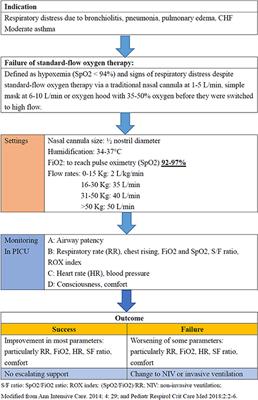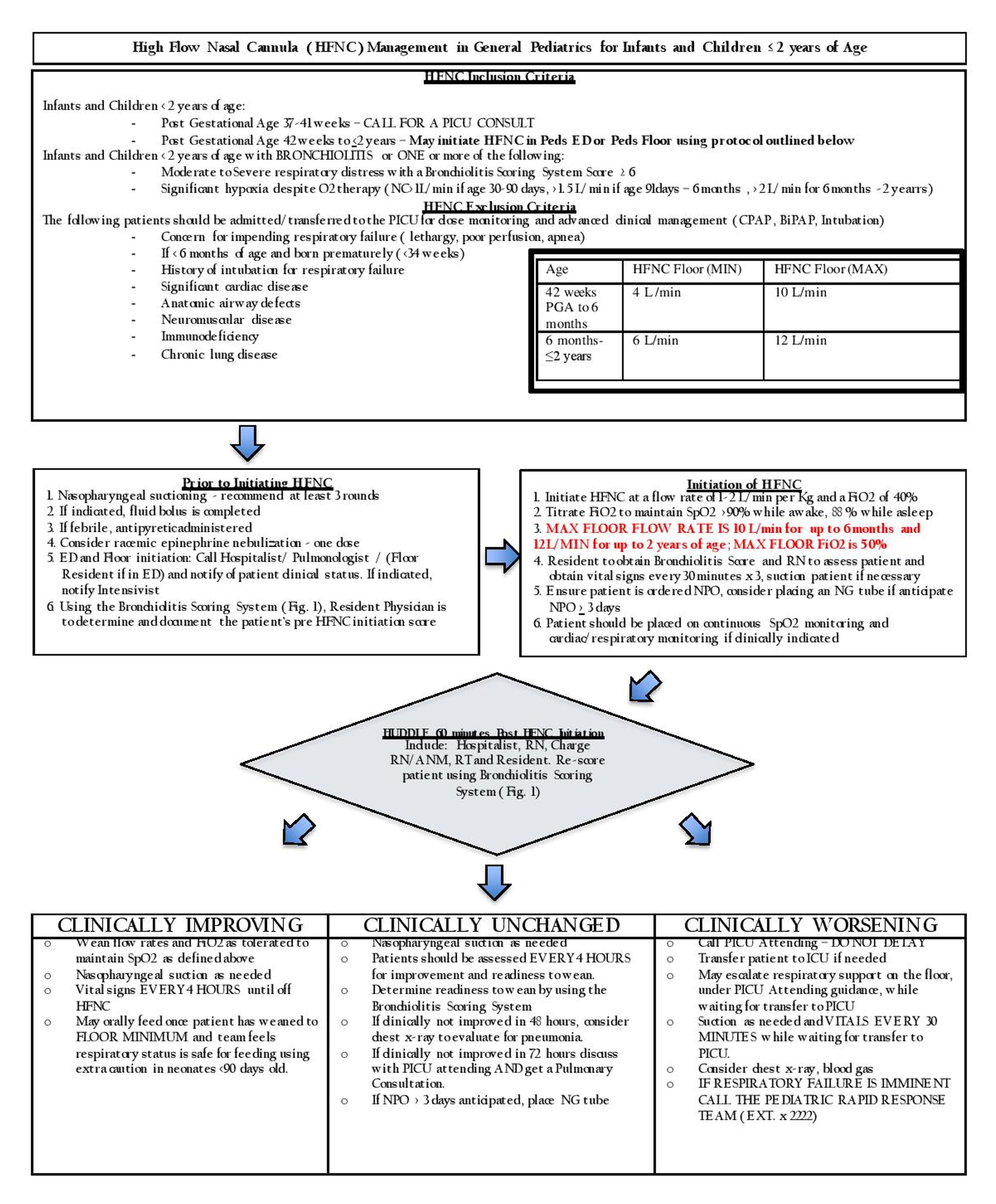high flow nasal cannula flow rate pediatrics
High flow is usually defined as flow rate 2 Lmin the flow rate depending on the type of cannula used but ranging from 4 to 70 Lmin 7. Ad Your Health Your Care Our Service Shop Now For 100 Price Guarantee.

High Flow Nasal Cannula Hfnc Part 2 Adult Pediatric Indications Rebel Em Emergency Medicine Blog
Hypoxemia was defined as.

. There were no clinical guidelines for ED HFNC initiation for bronchiolitis at our institution during the study period. However the effectiveness of HFNC therapy remains controversial. Usage of high-flow nasal cannula HFNC for bronchiolitis has become increasingly prevalent.
Subgroup analysis of hypoxemia incidence between high-flow nasal cannula oxygen HFNC and standard nasal cannula oxygen SNC. Ad Deliver Supplemental Oxygen To Patients Taking Oxygen Therapy Secure Positioning. RCTs showed HFNO usage was safe on.
Its use in pediatrics departments is more recent and generally is restricted to children with moderate bronchiolitis. Used when a higher F. Shop Save Today.
Ad Browse Our Huge Selection Of Discount Nasal Cannula Products. 47-12 However there is no evidence to support this practice for preterm neonates older children or adults. With oxygen titrated from a flow rate of 4 Lmin in infants up to 40 Lmin or more in adolescents.
1 Trends in paediatric ward admission rates have been increasing whereas paediatric intensive care unit PICU admission rates remain static. Debate is ongoing as to whether HFNC may reduce the use of less tolerated and more invasive ventilator supports such as continuous positive airway pressure CPAP and mechanical ventilation. Knowing the flow rate range is important since the positive distending pressure will increase as the flow rate increases which may help to explore the causes of complications like air leak syndrome that occurs in some patients in the.
Vapotherm Pediatric Pocket Guide 2 Hi-VNI Cannula Selection 1. The Relationship between High Flow Nasal Cannula Flow Rate and Effort of Breathing in Children. Weiler et al The Relationship Between High Flow Nasal Cannula Rate and Effort of Breathing in Children The Journal of Pediatrics.
Setting flow rates for infants and children Clinical evidence supports a dose-by-weight approach with suggested flow rates of approximately 2 liters per kilogram per minute Lkgmin for infants between 30 and 125 kilograms. High-flow nasal cannula HFNC is one of the most commonly used devices in coronavirus disease 2019 COVID-19 patients with acute respiratory failure owing to the provision of high oxygen concentration comfort facilitation of secretion removal patient compliance and ease of proning. Bronchiolitis is a common cause for hospital admissions.
In pediatrics high-flow nasal cannula HFNC therapy is an intermediate level of respiratory support with variability in practice. High-flow nasal cannula flow rate in young infants with severe viral bronchiolitis. The question is still open Intensive Care Med.
It delivers humidified oxygen up to a flow rate of 60 L. High-flow nasal cannula Delivers F. Open in a separate window Figure 4.
Our goal was to characterize HFNC usage rates and patient outcomes for children hospitalized with bronchiolitis at our institution and to inform quality improvement efforts to reduce potentially. Provides some positive end-expiratory pressure. In the neonatal ICU it has been associated with.
2 It has been suggested that High Flow Nasal cannula Oxygen HFNO may reduce the need for escalation of care. Hi-VNI Cannula Sizes Flow Range Tip OD Premature 1-8 Lmin 15 mm Neonatal 1-8 Lmin 15 mm SOLO single prong 1. A protocol allowing HFNC use at flow rates up to 6 Lminute on the general pediatric inpatient unit was implemented on January 1 2016 and this limit was increased to 2 L per patient kilogram per minute on January 24 2018.
There are limited data to inform consensus on optimal device parameters determinants of successful patient response and indications for escalation of support. High flow nasal cannula HFNC is commonly used as non-invasive respiratory support in critically ill children. Flow rate can be adjusted based on the childs respiratory effort.
Airway pressure generated from a high-flow system varies and depends on flow amount cannula and nares sizes and degree of mouth opening in an experimental study 7. The optimal HFNC flow rate to reduce effort of breathing in infants and young children is approximately 15-20 Lkgminute with more benefit seen in children 8 kg. It only stated that the maximum flow rate was 30 Lmin according to the international guidelines of HFNC in pediatric patients.
We conducted a pre-post intervention study of patients placed on HFNC therapy before and after the implementation of an HFNC protocol. Flow setting and cannula size for pediatric patients The aforementioned principle a higher flow setting than inspiratory demand can be applied to patients of all ages. With some end-expiratory pressure is required and ventilation is adequate.
Easy To Put On Or Take Off Even For A Reclining Patient Soft Curved Nasal Prongs. As we will discuss in our next section pediatric data particularly in bronchiolitis shows that flow rates of 2 Lkgmin are effective and well tolerated up to maximum flow rates of 60 Lkgmin in adults. High-flow nasal cannula HFNC is increasingly utilized in pediatrics delivering humidified air and oxygen for respiratory conditions causing hypoxia and distress.
To determine whether in infants with bronchiolitis admitted to a pediatric intensive care unit PICU the starting rate for high-flow nasal cannula HFNC therapy set by the attending physicians upon clinical judgment meets patients peak inspiratory flow PIF demands and how it influences respiratory mechanics and breathing effort. Over the last decade high-flow nasal cannula HFNC has increasingly been used for oxygen delivery in neonatology departments gradually replacing nasal continuous positive airway pressure CPAP.

Pdf High Flow Nasal Cannula Oxygen Therapy In Children A Clinical Review Semantic Scholar

Frontiers High Flow Nasal Cannula Therapy In Children With Acute Respiratory Distress With Hypoxia In A Pediatric Intensive Care Unit A Single Center Experience Pediatrics

Characteristics And Outcome Of High Flow Nasal Cannula Episodes Download Table

Cureus The Use Of High Flow Nasal Cannula And The Timing Of Safe Feeding In Children With Bronchiolitis

Initial Or Starting Flows Of High Flow Nasal Cannula In A Pediatric Download Table

What Role For High Flow Nasal Cannulae Neonatal Research

Hd High Flow Nasal Cannula Em Rap

Flow Chart Picu Pediatric Icu Hfnc High Flow Nasal Cannula Niv Download Scientific Diagram

Pdf Peep Generated By High Flow Nasal Cannula In A Pediatric Model Semantic Scholar